Identification and Location of a Transitional Zone between an Urban and a Rural Area Using Fuzzy Set Theory, CLC, and HRL Data
Abstract
1. Introduction
- Identification along the line of junction between the urban and rural methods of land use, in the belt whose width is equal to 3/10 of the radius of a circle circumscribed on compact area of urban investment [4].
- The transitional zone boundary is delineated based on the use type percentage in the measurement fields, analysis of the administrative border development, land use plans, taking into account the land topography and use, etc. [4].
- The zone border is delineated by the borders of areas that fulfil the conventional quantitative criteria, and one method of cluster analysis can be used to isolate a right number of clusters of measurement fields from the point of view of the transitional land use [4].
- Identification of land where professional urbanisation takes place [43].
- An analysis of progress of urbanisation processes—land organisation, functions, and development [6].
New Approach in Planning Process
2. Materials and Methods
2.1. Study Area
2.2. Determination of the Impact of Individual Forms of Land Use on Developing Urban or Rural Use
3. Result
3.1. Determination of the Degrees of Membership of Urban Use and of Rural Use in Different Forms of Spatial Use in the Study Area
3.2. Identification and Location of a Transitional Zone between Urban and Rural Areas Based
3.3. Verification of the Obtained Results
4. Discussion
5. Conclusions
Author Contributions
Funding
Conflicts of Interest
References
- Batty, M. New ways of looking at cities. Nature 1995, 377, 574. [Google Scholar] [CrossRef]
- Źróbek, S. Changes in Land Use in the Transition Zone between the City and the Village in the Light of Research and Forecasts. Ph.D. Thesis, ART, Olsztyn, Poland, 1983. (In Polish). [Google Scholar]
- Zaremba, P. Problems of the Future of Large Cities; PAN: Poznań, Poland, 1967. (In Polish) [Google Scholar]
- Hopfer, A.; Źróbek, S.; Źróbek, R. Planning and Arrangement Agricultural Aspects of Urban Development; Publishing House of the ART: Olsztyn, Poland, 1987. (In Polish) [Google Scholar]
- Mikielewicz, R. Border zone as a criterion for spatial development of the city. In Scientific Conference—Spatial Management of Polish Cities and Villages of the 21st Century; Wyższa Szkoła Finansów i Zarządzania w Białymstoku: Białystok, Poland, 2001. (In Polish) [Google Scholar]
- Słodczyk, J. City Space and Its Transformations; Studia i monografie nr 298; University of Opole: Opole, Poland, 2003. (In Polish) [Google Scholar]
- Douglas, I. Peri-Urban Ecosystems and Societies: Transitional Zones and Contrasting Values. In The Peri-Urban Interface. Approaches to Sustainable Natural and Human Resource Use; McGregor, D., Simon, D., Eds.; CRC Press: London, UK, 2006. [Google Scholar] [CrossRef]
- Ahmad, J.; Nusrath, A.; Shivamallu, D. A literature survey on rural urban fringe. J. Int. Acad. Res. Multidiscip. 2014, 2, 504–517. [Google Scholar]
- Antrop, M. Sustainable Landscapes: Contradiction, Fiction or Utopia? Landscape and Urban Planning 75; Elsevier: Amsterdam, The Netherlands, 2006; pp. 187–197. [Google Scholar] [CrossRef]
- Dangalle, N.; Närman, A. Peri-Urban Development in Gampaha District, Sri Lanka. In The Peri-Urban Interface. Approaches to Sustainable Natural and Human Resource Use; McGregor, D., Simon, D., Eds.; CRC Press: London, UK, 2006. [Google Scholar] [CrossRef]
- Lin, G.C.S. Evolving Spatial Form of Urban-Rural Interaction in the Pearl River Delta, China. Prof. Geogr. 2001, 53, 56–70. [Google Scholar] [CrossRef]
- Simon, D. Urban Environments: Issues on the Peri-Urban Fringe. Annu. Rev. Environ. Resour. 2008, 33, 167–185. [Google Scholar] [CrossRef]
- Siemiński, J. Rural-urban continuum and some of its infrastructural problems. Infrastruct. Ecol. Rural Areas 2010, 2, 215–228. [Google Scholar]
- Sobotka, S. Transformation of the historical spatial arrangements of the villages in the suburban area of Olsztyn, with particular emphasis on Brąswałd, Dorotowo and Jonkowo. Acta Sci. Pol. Administratio Locorum 2014, 13, 39–68. (In Polish) [Google Scholar]
- Szmytkie, R. Methods of Analysis of the Morphology and Physiomic of Sedate Units; Scientific hearings of the Institute of Geography and Regional Development of the University of Wrocław no. 35; The University of Wrocław: Wrocław, Poland, 2014. (In Polish) [Google Scholar]
- Konecka-Szydłowska, B. The smallest cities in Poland in terms of the concept of urban-rural continuums. Reg. Dev. Reg. Policy 2018, 41, 151–165. (In Polish) [Google Scholar]
- Degórska, B. Spatial Urbanization of Rural Areas in the Metropolitan Area of Warsaw. Ecological and Landscape Context; Stanisława Leszczyckiego, Polish Academy of Sciences, Geographic work, no 262; Institute of Geography and Spatial Development im.: Warsaw, Poland, 2017. (In Polish) [Google Scholar]
- Ravetz, J.; Warhurst, P. Manchester: Re-Inventing the Local–Global in the Peri-Urban City-Region. In Peri-Urban Futures: Scenarios and Models for Land Use Change in Europe; Nilsson, K., Pauleit, S., Bell, S., Aalbers, C., Sick Nielsen, T., Eds.; Springer: Berlin/Heidelberg, Germany, 2013. [Google Scholar] [CrossRef]
- Loibl, W.; Piorr, A.; Ravetz, J. Concepts and methods. In Peri-Urbanisation in Europe: Towards a European Policy to Sustain Urban-Rural Futures; Piorr, A., Ravetz, J., Tosics, I., Eds.; University of Copenhagen, Academic Books Life Sciences: Copenhagen, Denmark, 2011; pp. 24–29. [Google Scholar]
- Labbé, D. Facing the Urban Transition in Hanoi: Recent Urban Planning Issues and Initiatives; Institut national de la reherche scientifique Centre—Urbanisation Culture Société: Montreal, QC, Canada, 2010. [Google Scholar]
- Csatári, B.; Farkas, J.Z.; Lennert, J. Land Use Changes in the Rural-Urban Fringe of Kecskemét after the Economic Transition. J. Settl. Spat. Plan. 2013, 4, 153–159. [Google Scholar]
- Nabielek, K.; Kronberger-Nabielek, P.; Hamers, D. The rural-urban fringe in the Netherlands: Recent developments and future challenges. SPOOL 2013, 1, 1–18. [Google Scholar] [CrossRef]
- Simon, D.; McGregor, D.; Nsiah-Gyabaah, K. The changing urban–rural interface of African cities: Definitional issues and an application to Kumasi, Ghana. Environ. Urban. 2004, 16, 235–248. [Google Scholar]
- Tacoli, C. The links between rural and urban development. Environ. Urban. 2003, 15, 3–12. [Google Scholar] [CrossRef]
- Hoffmann, E.; Jose, M.; Nölke, N.; Möckel, T. Construction and Use of a Simple Index of Urbanisation in the Rural–Urban Interface of Bangalore, India. Sustainability 2017, 9, 2146. [Google Scholar] [CrossRef]
- Gallent, N. The Rural–Urban fringe: A new priority for planning policy? Plan. Pract. Res. 2006, 21, 383–393. [Google Scholar] [CrossRef]
- Gant, R.; Robinson, G.; Shahab, F. Land-use change in the ‘edgelands’: Policies and pressures in London’s rural–urban fringe. Land Use Policy 2011, 28, 266–279. [Google Scholar] [CrossRef]
- Gallent, N.; Shaw, D. Spatial planning, area action plans and the rural-urban fringe. J. Environ. Plan. Manag. 2001, 50, 617–638. [Google Scholar] [CrossRef]
- Hao, P.; Geertman, S.; Hooimeijer, P.; Sliuzas, R. The land-use diversity in urban villages in Shenzhen. Environ. Plan. 2012, 44, 2742–2764. [Google Scholar] [CrossRef]
- Datta, R. Territorial Integration: An Approach to address Urbanising Villages in the Planning for Delhi Metropolitan Area, India. In Proceedings of the Territorial Integration of Urbanising Villages 40th ISoCaRP Congress, Geneva, Switzerland, 22 September 2004. [Google Scholar]
- Bilozor, A.; Renigier-Bilozor, M. Procedure of Assessing Usefulness of the Land in the Process of Optimal Investment Location for Multi-Family Housing Function. Procedia Eng. 2016, 161, 1868–1873. [Google Scholar] [CrossRef]
- Biłozor, A.; Renigier-Biłozor, M.; Cellmer, R. Assessment Procedure of Suburban Land Attractiveness and Usability for Housing. In Proceedings of the Baltic Geodetic Congress, Olsztyn, Poland, 21–23 June 2018. [Google Scholar] [CrossRef]
- Renigier-Bilozor, M.; Bilozor, A. Optimization of the Variables Selection in the Process of Real Estate Markets Rating. Oeconomia Copernic. 2015, 6, 139–157. [Google Scholar] [CrossRef]
- Ready, R.; Abdalla, C. GIS Analysis of Land Use on the Rural-Urban Fringe: The Impact of Land Use and Potential Local Disamenities on Residential Property Values and on the Location of Residential Development in Berks County, Pennsylvania; Final Report. Staff Paper 364; The Pennsylvania State University: Philadelphia, PA, USA, 2003. [Google Scholar]
- Renigier-Bilozor, M.; Wisniewski, R.; Bilozor, A. Rating attributes toolkit for the residential property market. Int. J. Strateg. Prop. Manag. 2017, 21, 307–317. [Google Scholar] [CrossRef]
- Renigier-Bilozor, M. Modern classification system of real estate markets. Geod. Vestn. 2017, 61, 441–460. [Google Scholar] [CrossRef]
- Hassea, J.; Lathrop, R. Land resource impact indicators of urban sprawl. Appl. Geogr. 2003, 3, 159–175. [Google Scholar] [CrossRef]
- EEA Report, 2016, Urban Sprawl in Europe, Joint EEA-FOEN Report, European Environment Agency, EEA Report No 11/2016. Publications Office of the European Union: Luxembourg. Available online: https://www.eea.europa.eu/publications/ urban-sprawl-in-europe (accessed on 10 September 2019).
- Zhao, P. Managing urban growth in a transforming China: Evidence from Beijing. Land Use Policy 2011, 28, 96–109. [Google Scholar] [CrossRef]
- Jaeger, J.A.G.; Bertiller, R.; Schwick, C.; Kienast, F. Suitability criteria for measures of urban sprawl. Ecol. Indic. 2010, 10, 397–406. [Google Scholar] [CrossRef]
- Jaeger, J.A.G.; Schwick, C. Improving the measurement of urban sprawl: Weighted Urban Proliferation (WUP) and Its application to Switzerland. Ecol. Indic. 2014, 38, 294–308. [Google Scholar] [CrossRef]
- Leontidou, L.; Afouxenidis, A.; Kourliouros, E.; Marmaras, E. Infrastructurerelated urban sprawl: Mega-events and hybrid peri-urban landscapes in Southern Europe. In Urban Sprawl in Europe: Landscape, Land-Use Change and Policy; Couch, C., Leontidou, L., Petschel-Held, G., Eds.; Blackwell Publishing: London, UK, 2007; pp. 71–101. [Google Scholar]
- Małuszyńska, E. Transformation of the suburban area of Poznańska agglomerations. In New Problems in the Development of Big Cities and Regions; Domański, R., Ed.; KPZK PAN Biuletyn 192: Warsaw, Poland, 2000. (In Polish) [Google Scholar]
- Amato, F.; Tonini, M.; Murgante, B.; Kanevski, M. Fuzzy definition of Rural Urban Interface: An application based on land use change scenarios in Portugal. Environ. Model. Softw. 2018, 104. [Google Scholar] [CrossRef]
- Titisari, T.; Maheshwari, D.B.; Hagare, D. Defining rural–urban interfaces for understanding ecohydrological processes in West Java, Indonesia: Part II. Its application to quantify rural–urban interface ecohydrology. Ecohydrol. Hydrobiol. 2018, 18, 37–51. [Google Scholar] [CrossRef]
- Lerner, A.M.; Eakin, H. An obsolete dichotomy? Rethinking the rural–urban interface in terms of food security and production in the global south. Geogr. J. 2011, 177, 311–320. [Google Scholar] [CrossRef]
- Thapa, R.B.; Murayama, Y. Urban Mapping, Accuracy, & Image Classification: A Comparison of Multiple Approaches in Tsukuba City, Japan. Appl. Geogr. 2009, 29, 135–144. [Google Scholar] [CrossRef]
- Treitz, P. Remote sensing for mapping and monitoring land-cover and land-use change. Prog. Plan. 2004, 61, 267. [Google Scholar] [CrossRef]
- Alqurashi, A.F.; Kumar, L. Investigating the Use of Remote Sensing and GIS Techniques to Detect Land Use and Land Cover Change. Adv. Remote Sens. 2013, 2, 193–204. [Google Scholar] [CrossRef]
- Rogan, J.; Chen, D.M. Remote Sensing Technology for Mapping and Monitoring Land-Cover and Land-Use Change. Prog. Plan. 2004, 61, 301–325. [Google Scholar] [CrossRef]
- Pelorosso, R.; Leone, A.; Boccia, L. Land Cover and Land Use Change in the Italian Central Apennines: A Comparison of Assessment Methods. Appl. Geogr. 2009, 29, 35–48. [Google Scholar] [CrossRef]
- Cieślak, M.; Smoluk, A. Fuzzy Sets. Image Recognition. Theory of Disasters. Choice of Texts; State Scientific Publishing House: Warsaw, Poland, 1988. (In Polish) [Google Scholar]
- Hopkins, M. Cruising the Internet in Pursuit of Fuzzy Logic; Azerbaijan International, Winter: Sherman Oaks, CA, USA, 1994; p. 24. Available online: https://www.azer.com/aiweb/categories/magazine/24_folder/24_articles/24_fuzzyinternet.html (accessed on 10 October 2019).
- Nowak, E. Study of socio-economic diversity of municipalities in the province. The use of fuzzy aggregates analysis. In Theoretical Concepts and Methods of Study of Socio-Economic Geography and Spatial Management; Rogacki, H., Ed.; Bogucki Wydawnictwo Naukowe: Poznań Poland, 2001. (In Polish) [Google Scholar]
- Biłozor, A. Application of Fuzzy Logic to the Identificationand Localization of the Fringe Areas of the Cityand the Village—Acat Scientiarum Polonorum. Administratio Locorum; UWM: Olsztynie, Poland, 2005; Volume 4, pp. 1–2. (In Polish) [Google Scholar]
- Chyl, S. Methodical Aspects of the Use of Measures Blurred for the Valorisation of Space for Agricultural Purposes. Nature—Spatial Conditionality of Rural Development; Notebooks of the Rural Development Society: Olsztyn, Poland, 2002; Volume 4. (In Polish) [Google Scholar]
- Men, B.; Liu, H.; Tian, W.; Liu, H. Evaluation of Sustainable Use of Water Resources in Beijing Based on Rough Set and Fuzzy Theory. Water 2017, 9, 852. [Google Scholar] [CrossRef]
- Cardone, B.; Di Martino, F. A New Geospatial Model Integrating a Fuzzy Rule-Based System in a GIS Platform to Partition a Complex Urban System in Homogeneous Urban Contexts. Geosciences 2018, 8, 440. [Google Scholar] [CrossRef]
- Ghajari, Y.E.; Alesheikh, A.A.; Modiri, M.; Hosnavi, R.; Abbasi, M. Spatial Modelling of Urban Physical Vulnerability to Explosion Hazards Using GIS and Fuzzy MCDA. Sustainability 2017, 9, 1274. [Google Scholar] [CrossRef]
- Zadeh, L.A. Fuzzy Sets. Inf. Control 1965, 8, 338–353. [Google Scholar] [CrossRef]
- Rutkowska, D.; Piliński, M.; Rutkowski, L. Neural Networks, Genetic Algorithms and Fuzzy Systems; Scientific Publishing PWN: Warsaw, Poland, 1999. (In Polish) [Google Scholar]
- Piegat, A. Fuzzy Modeling and Control; Academic Publishing Officer Exit: Warsaw, Poland, 1999. [Google Scholar]
- Zilberstein, S. What is ‘Fuzzy Logic’? Are There Computers that Are Inherently Fuzzy and Do not Apply the Usual Binary Logic? 21 October 1999. Available online: https://www.scientificamerican.com/article/what-is-fuzzy-logic-are-t/ (accessed on 14 October 2019).
- Łachwa, A. Fuzty World of Collections, Numbers, Relationships, Facts, Rules and Decisions; Academic Publishing Officer Exit: Warsaw, Poland, 2001. (In Polish) [Google Scholar]
- Molecki, B. Genetic Algorithms and Fuzta Logic; Wrocław University of Science and Technology: Wrocław, Poland, 1998. (In Polish) [Google Scholar]
- Asadi, P.; Hosseini, S.M.; Ataie-Ashtiani, B.; Simmons, C.T. Fuzzy Vulnerability Mapping of Urban Groundwater Systems to Nitrate Contamination. Environ. Model. Software 2017, 96, 146–157. [Google Scholar] [CrossRef]
- González-Arteaga, T.; Calle, R.; Martínez, L. Managing Interacting Criteria: Application to Environmental Evaluation Practices. Axioms 2018, 7, 4. [Google Scholar] [CrossRef]
- Burrough, P.A. Fuzzy mathematical methods for soil survey and land evaluation. J. Soil Sci. 1989, 40, 477–492. [Google Scholar] [CrossRef]
- Power, C.; Simms, A.; White, R. Hierarchical fuzzy pattern matching for the regional comparison of land use maps. Int. J. Geogr. Inf. Sci. 2001, 15, 77–100. [Google Scholar] [CrossRef]
- Sheehan, T.; Gough, M. A platform-independent fuzzy logic modeling framework for environmental decision support. Ecol. Inf. 2016, 34, 92–101. [Google Scholar] [CrossRef]
- Antrop, M.; Van Eetvelde, V. Holistic aspects of suburban landscapes: Visual image interpretation and landscape metrics. Landsc. Urban Plan. 2000, 50, 43–58. [Google Scholar] [CrossRef]
- Antrop, M. Changing patterns in the urbanized countryside of Western Europe. Landsc. Ecol. 2000, 15, 257–270. [Google Scholar] [CrossRef]
- Vermeulen, F.; Antrop, M.; Hageman, B.; Wiedemann, T. Ancient Roads and Fields in Northwestern Gaul—A GIS-Based Analysis. In Proceedings of the 28th Conference, Ljubljana, April 2000 (BAR International Series 931) Computing Archaeology for Understanding the Past. CAA 2000. Computer Applications and Quantitative Methods in Archaeology; Stančič, Z., Veljanovski, T., Eds.; Archaeopress: Oxford, UK, 2001; pp. 187–196. [Google Scholar]
- Bajerowski TBal, A.; Biłozor, A.; Gerus-Gościewska, M.; Sidor, I.; Szurek, M.; Turkowska, O.; Wielgosz, A. Theoretical Foundations of Spatial Management and Space Management; UWM: Olsztyn, Poland, 2003. (In Polish) [Google Scholar]
- Biłozor, A. Urban land use changes forecasting. In Proceedings of the 9th International Conference on Environmental Engineering. Section: Sustainable Urban Development, Vilnius, Lithuania, 22–23 May 2014; ISBN 978-609-457-640-9. [Google Scholar]
- Regulation of the Minister of Infrastructure of 26 August 2003 Regarding the Required Scope of the Project of a Local Spatial Development Plan. Dz.U. 2003, nr 164 poz. 1587. Available online: http://prawo.sejm.gov.pl/isap.nsf/download.xsp/WDU20031641587/O/D20031587.pdf (accessed on 14 October 2019). (In Polish)
- Szuniewicz, K. Methodology of space assessment and valorisation. In Contemporary Valorization of Urban Space; Cieślak, I., Ed.; UWM: Olsztyn, Poland, 2012. (In Polish) [Google Scholar]
- Cieślak, I.; Szuniewicz, K.; Pawlewicz, K.; Czyża, S. Land Use Changes Monitoring with CORINE Land Cover Data. IOP Conf. Series Mater. Sci. Eng. 2017, 245, 052049. [Google Scholar] [CrossRef]
- Heymann, Y.; Steenmans, C.; Croisille, G.; Bossard, M. CORINE Land Cover. Technical Guide 1994. Luxembourg (Office for Official Publications of European Communities). Available online: https://www.researchgate.net/profile/Nicolas_Sifakis/publication/259295513_Corine_Land_Cover_Technical_Guide_Part_I/links/53f713680cf2fceacc74ece5/Corine-Land-Cover-Technical-Guide-Part-I.pdf (accessed on 14 September 2019).
- Kuc, G.; Chormański, J. Sentinel-2 imagery for mapping and monitoring imperviousness in urban areas. Int. Arch. Photogramm. Remote Sens. Spatial Inf. Sci. 2019, Volume XLII-1/W2, 43–47. Available online: https://www.int-arch-photogramm-remote-sens-spatial-inf-sci.net/XLII-1-W2/43/2019/ (accessed on 14 September 2019).
- Lefebvre, A.; Sannier, C. Monitoring Urban Areas with Sentinel-2A Data: Application to the Update of the Copernicus High Resolution Layer Imperviousness Degree. Remote Sens. 2016, 8, 606. [Google Scholar] [CrossRef]
- Heymans, A.; Jessica Breadsell, J.; Morrison, G.; Byrne, J.; Eon, C. Ecological Urban Planning and Design: A Systematic Literature Review. Sustainability 2019, 11, 3723. [Google Scholar] [CrossRef]
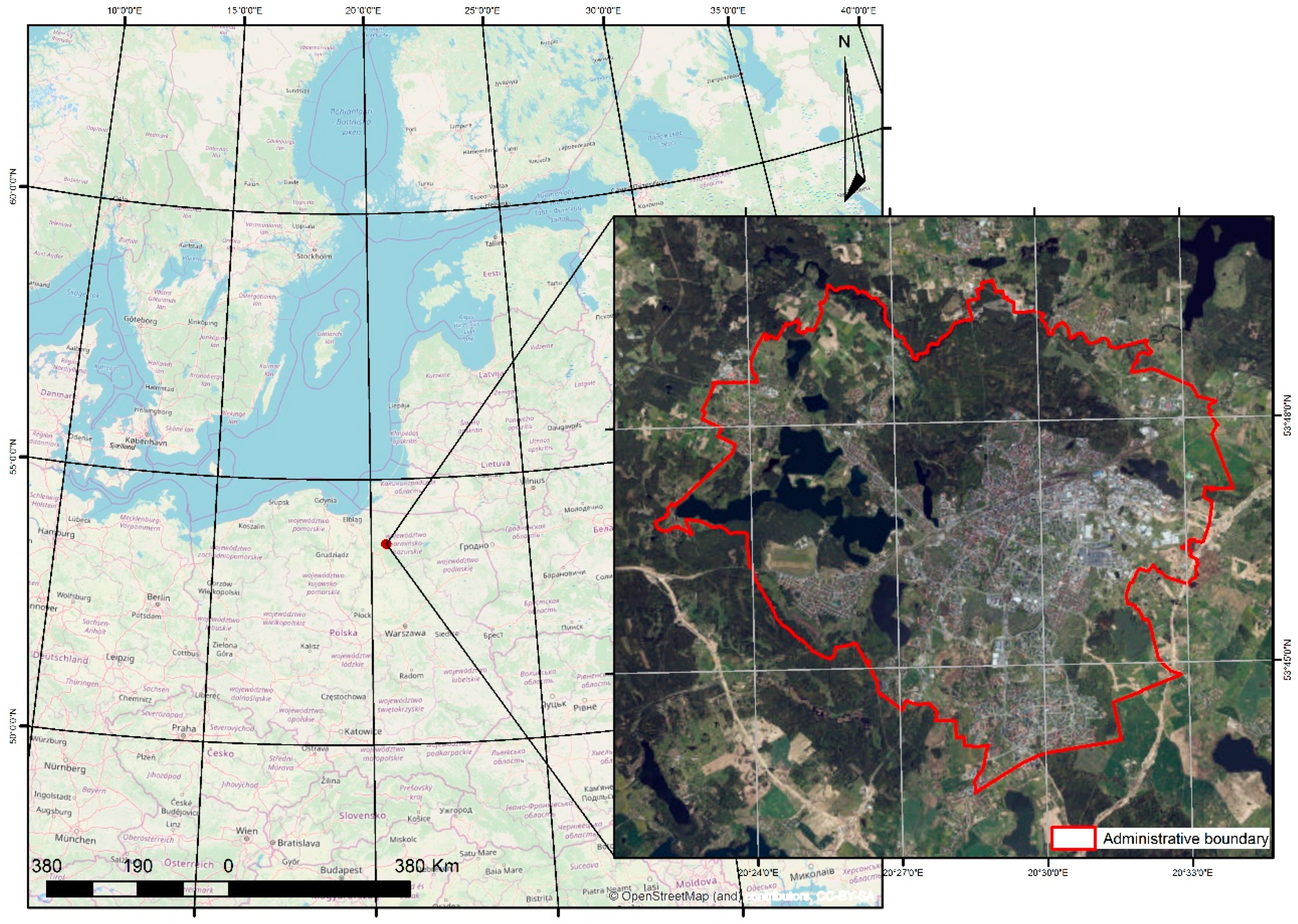
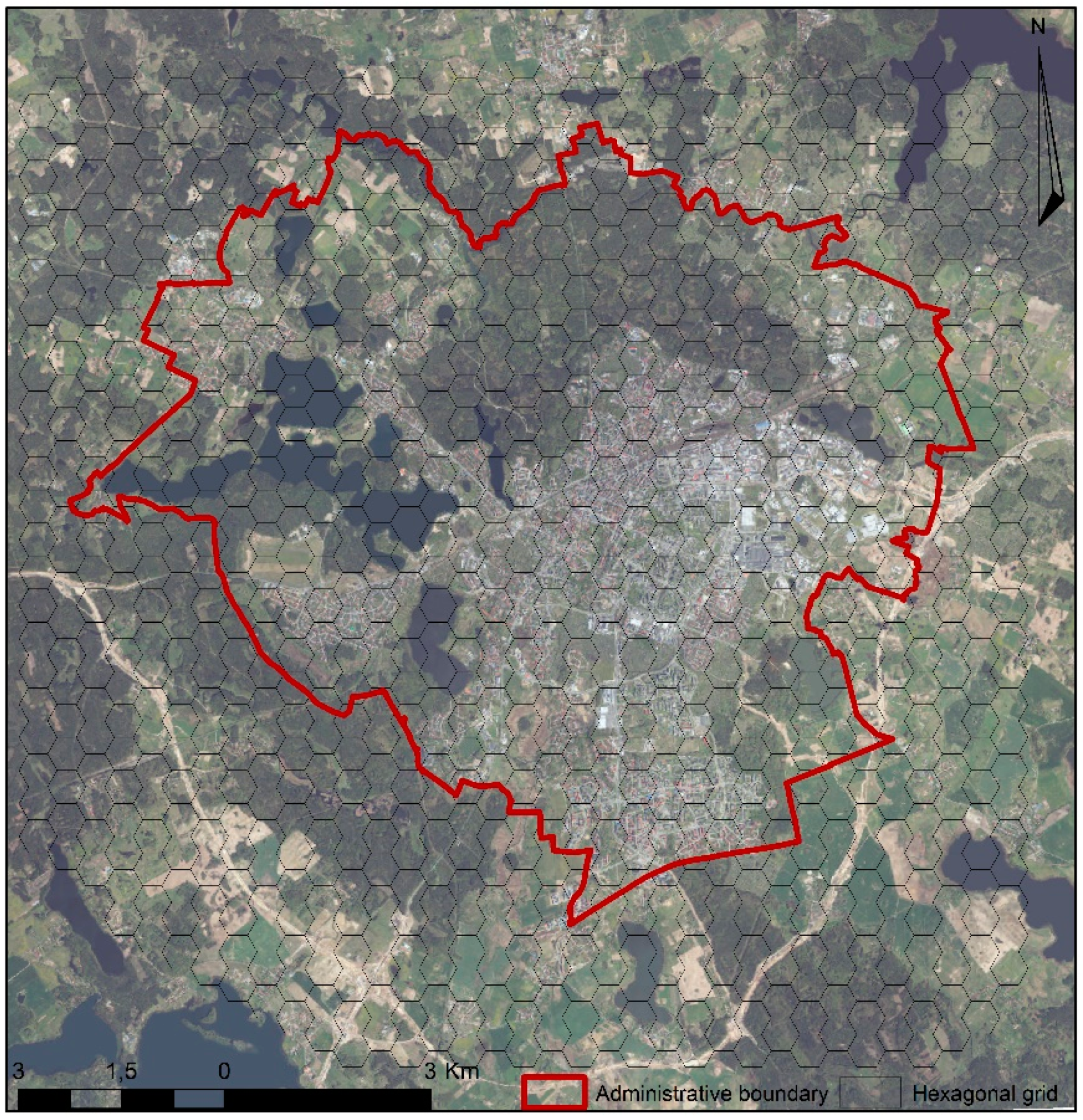



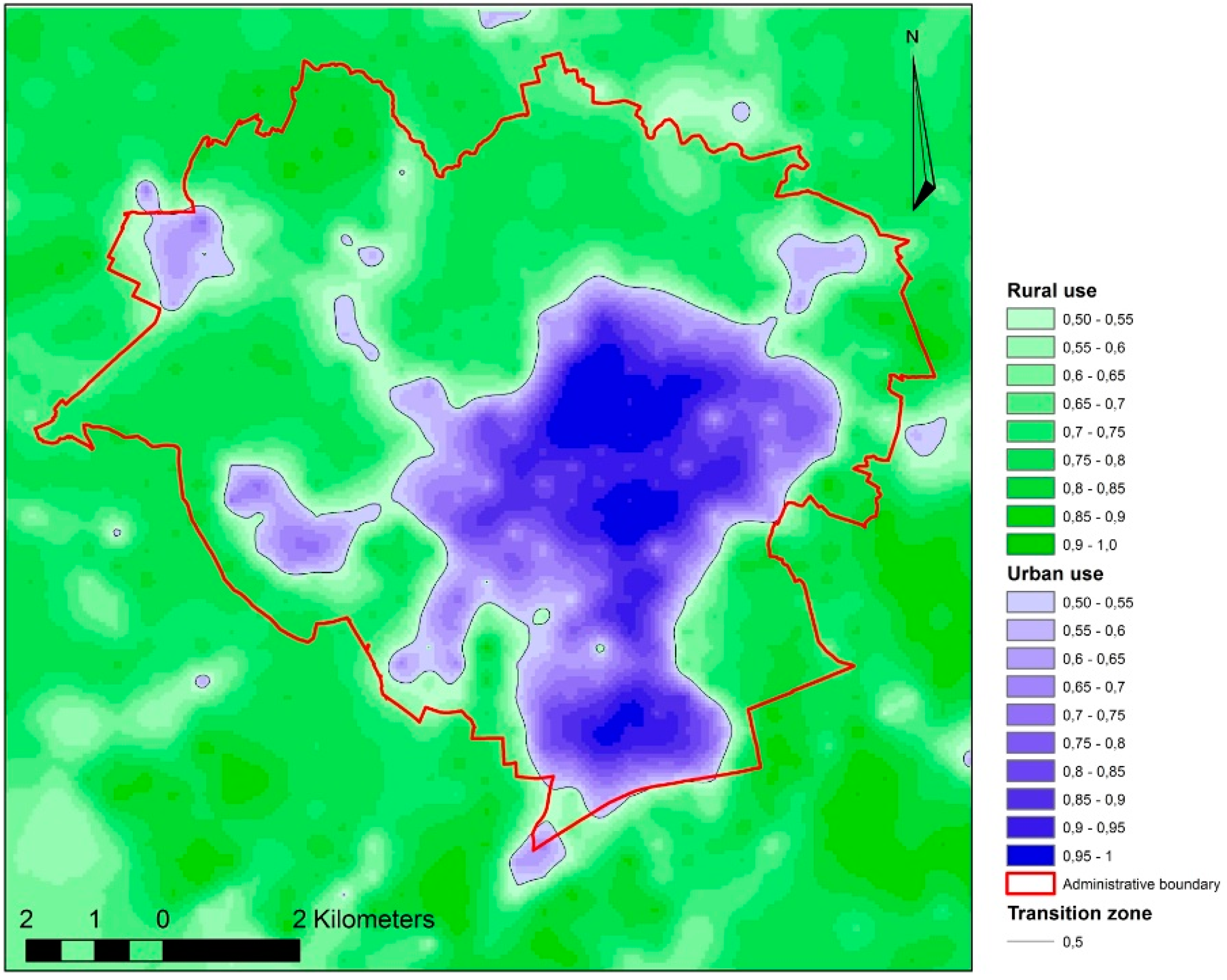
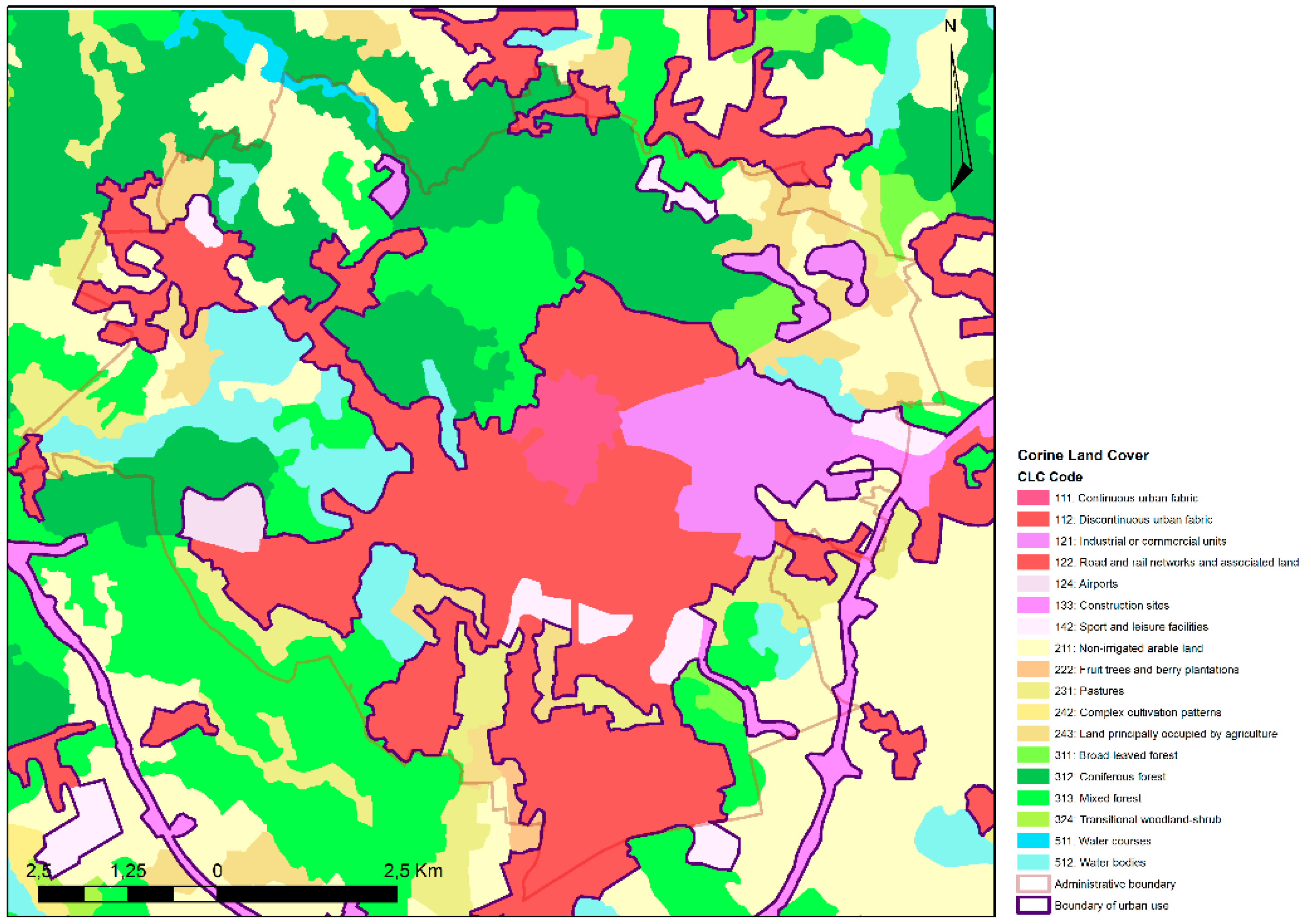
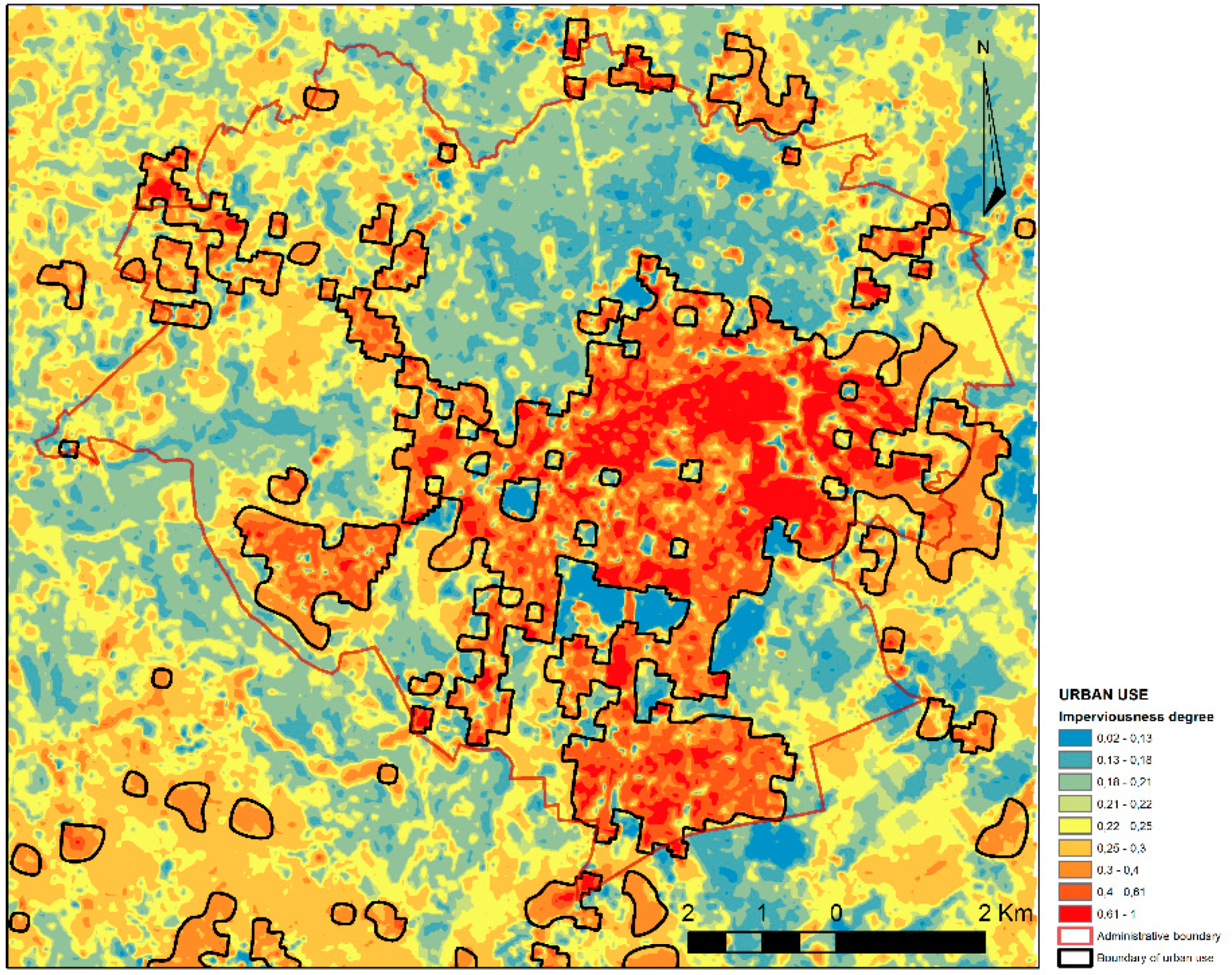
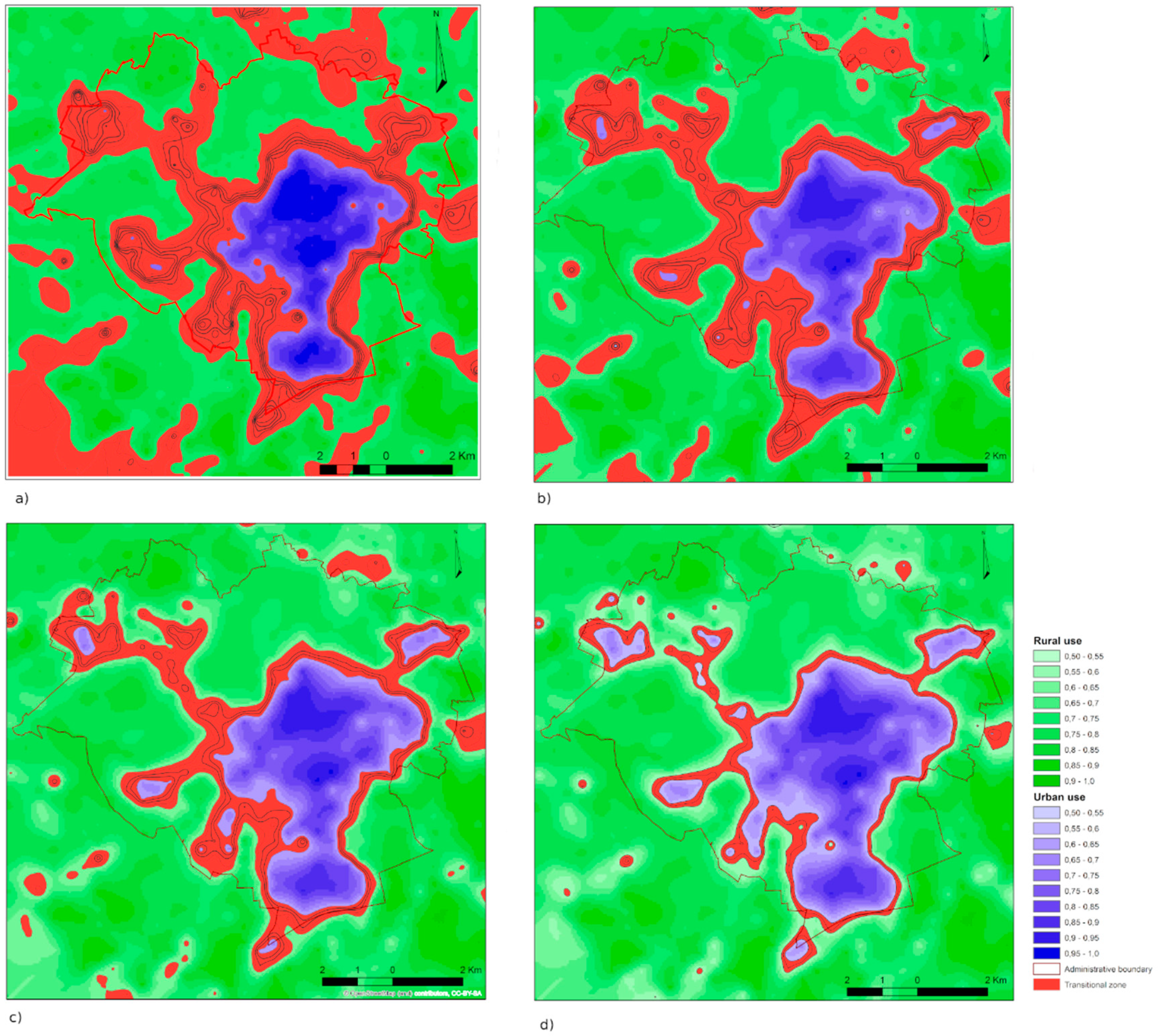

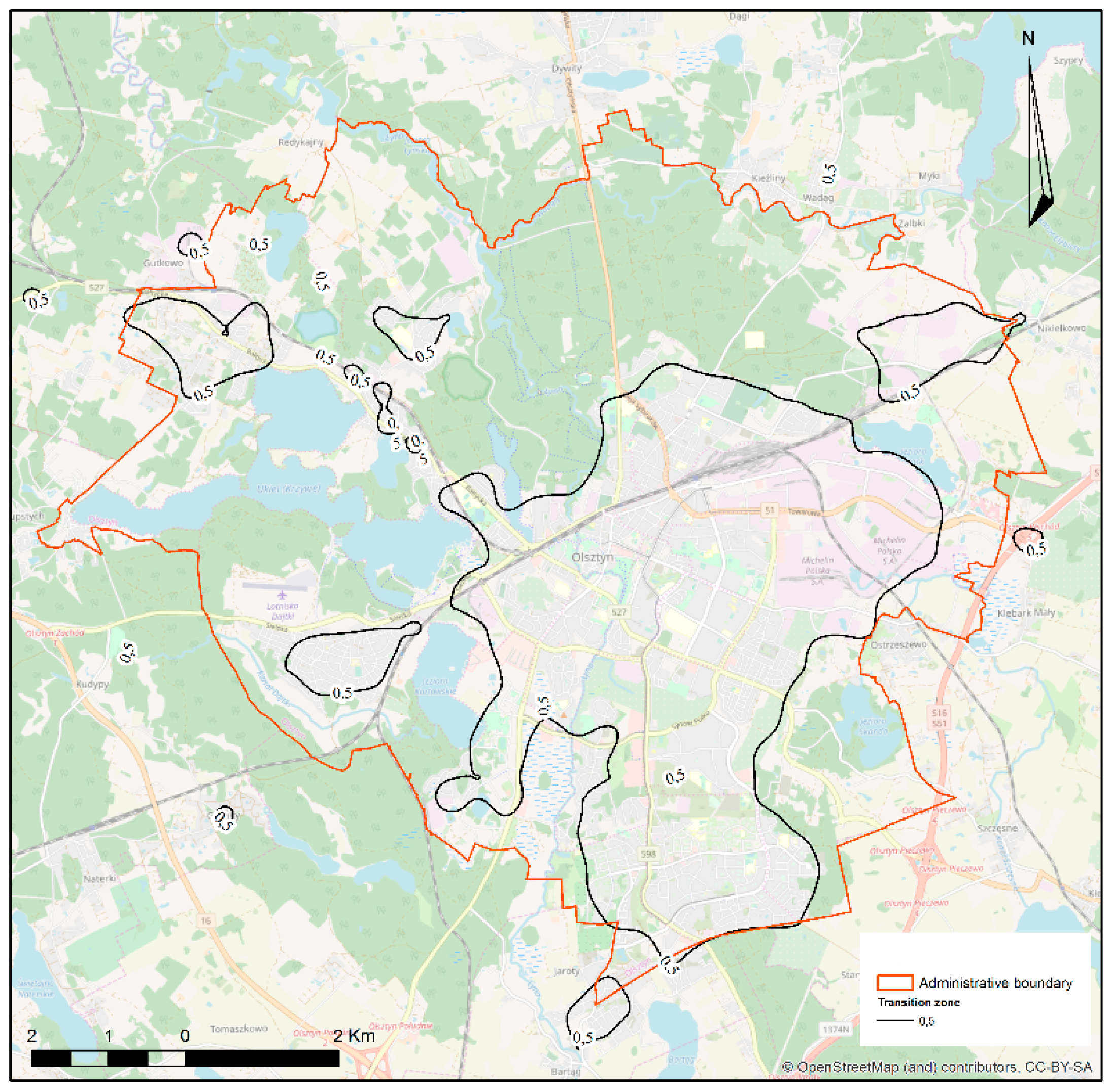
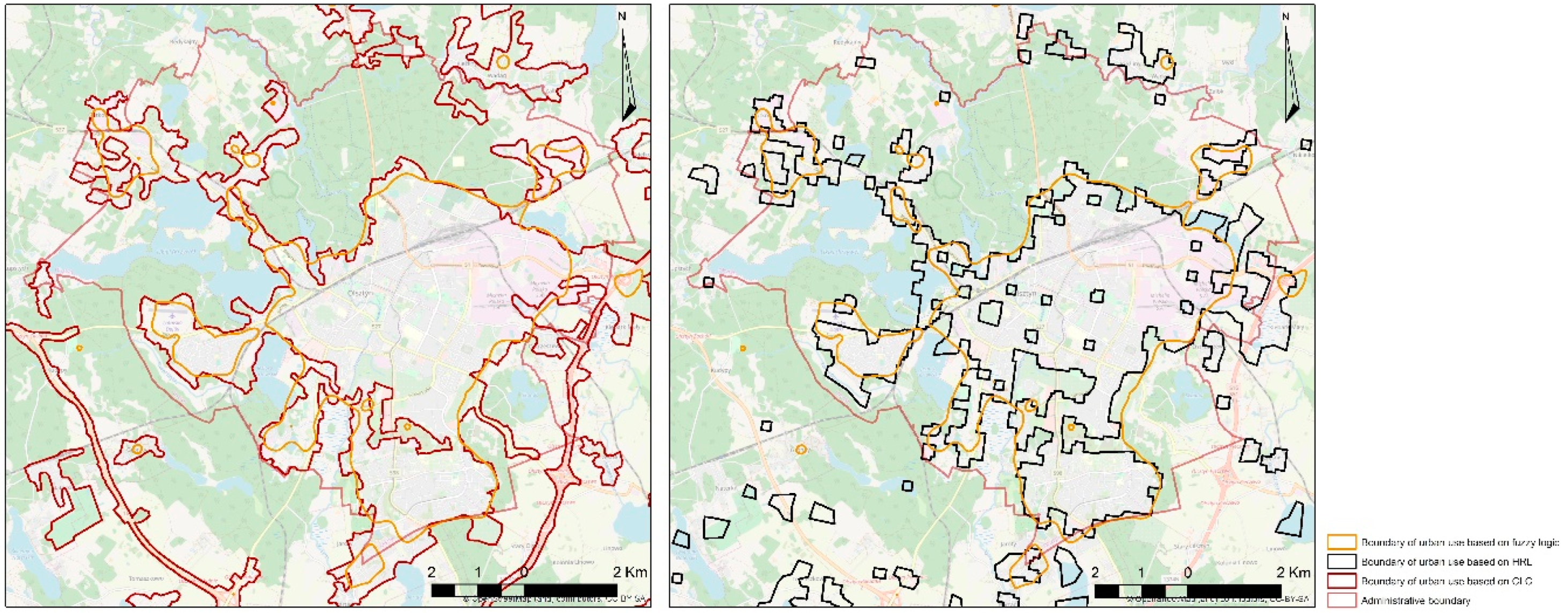
| No. | Forms of Space Use | Symbols of Space Use Forms | Degree of Membership of A Town |
|---|---|---|---|
| 1 | Single-family housing development area | MN | 0.69 |
| 2 | Multi-family housing development area | MW | 1.00 |
| 3 | Service establishments area | U | 0.92 |
| 4 | Sports and leisure area | US | 0.66 |
| 5 | Commercial facilities exceeding 2000 m2 of sales area | UC | 0.90 |
| 6 | Agricultural land | R | 0.09 |
| 7 | Orchards and market gardens | RS | 0.26 |
| 8 | Area of auxiliary services for farms, breeding centres, market gardens, forests and fish farms | RU | 0.10 |
| 9 | Area of farmstead buildings in crop growing farms, livestock farms, market gardens | RM | 0.16 |
| 10 | Area of production plants and warehouses | P | 0.97 |
| 11 | Mining areas | PG | 0.34 |
| 12 | Forests | ZL | 0.20 |
| 13 | Areas of arranged greenery | ZP | 0.68 |
| 14 | Areas of natural (unarranged) greenery | ZN | 0.35 |
| 15 | Garden plots | ZD | 0.45 |
| 16 | Cemeteries | ZC | 0.51 |
| 17 | Marine surface waters | WM | 0.20 |
| 18 | Inland surface waters | WS | 0.20 |
| 19 | Public roads | KD | 0.82 |
| 20 | Internal roads | KDW | 0.80 |
| 21 | Water transport routes | KW | 0.52 |
| 22 | Technical infrastructure | IT | 0.66 |
| 23 | Special areas—military, police | TS | 0.76 |
| 24 | Objects under construction | B | 0.64 |
© 2019 by the authors. Licensee MDPI, Basel, Switzerland. This article is an open access article distributed under the terms and conditions of the Creative Commons Attribution (CC BY) license (http://creativecommons.org/licenses/by/4.0/).
Share and Cite
Biłozor, A.; Czyża, S.; Bajerowski, T. Identification and Location of a Transitional Zone between an Urban and a Rural Area Using Fuzzy Set Theory, CLC, and HRL Data. Sustainability 2019, 11, 7014. https://doi.org/10.3390/su11247014
Biłozor A, Czyża S, Bajerowski T. Identification and Location of a Transitional Zone between an Urban and a Rural Area Using Fuzzy Set Theory, CLC, and HRL Data. Sustainability. 2019; 11(24):7014. https://doi.org/10.3390/su11247014
Chicago/Turabian StyleBiłozor, Andrzej, Szymon Czyża, and Tomasz Bajerowski. 2019. "Identification and Location of a Transitional Zone between an Urban and a Rural Area Using Fuzzy Set Theory, CLC, and HRL Data" Sustainability 11, no. 24: 7014. https://doi.org/10.3390/su11247014
APA StyleBiłozor, A., Czyża, S., & Bajerowski, T. (2019). Identification and Location of a Transitional Zone between an Urban and a Rural Area Using Fuzzy Set Theory, CLC, and HRL Data. Sustainability, 11(24), 7014. https://doi.org/10.3390/su11247014






